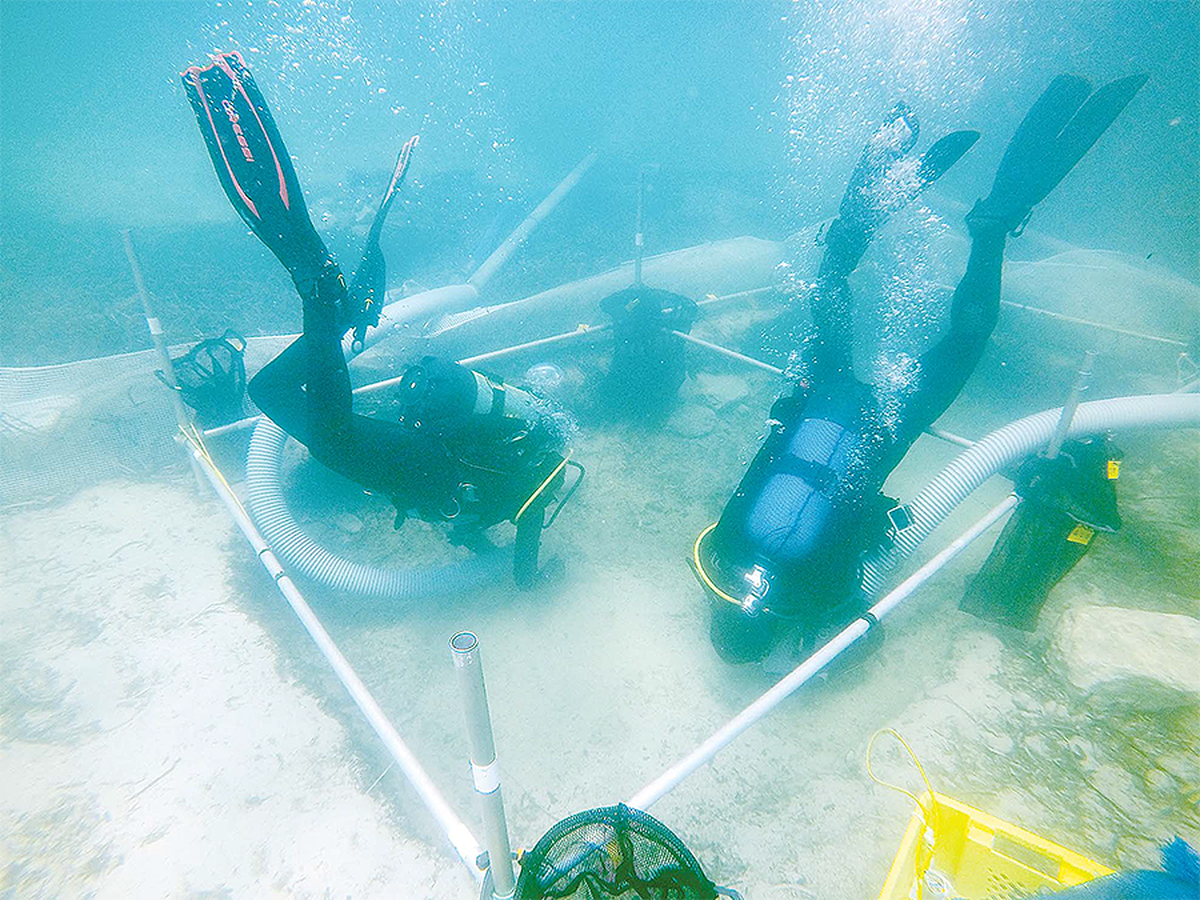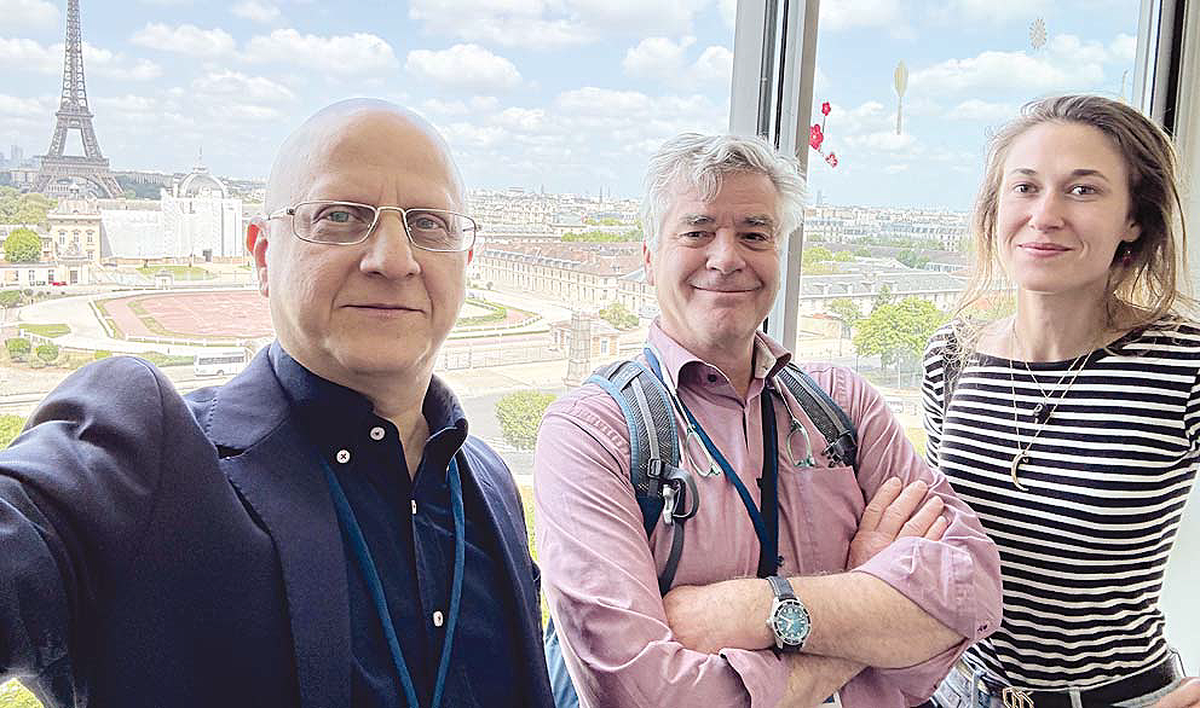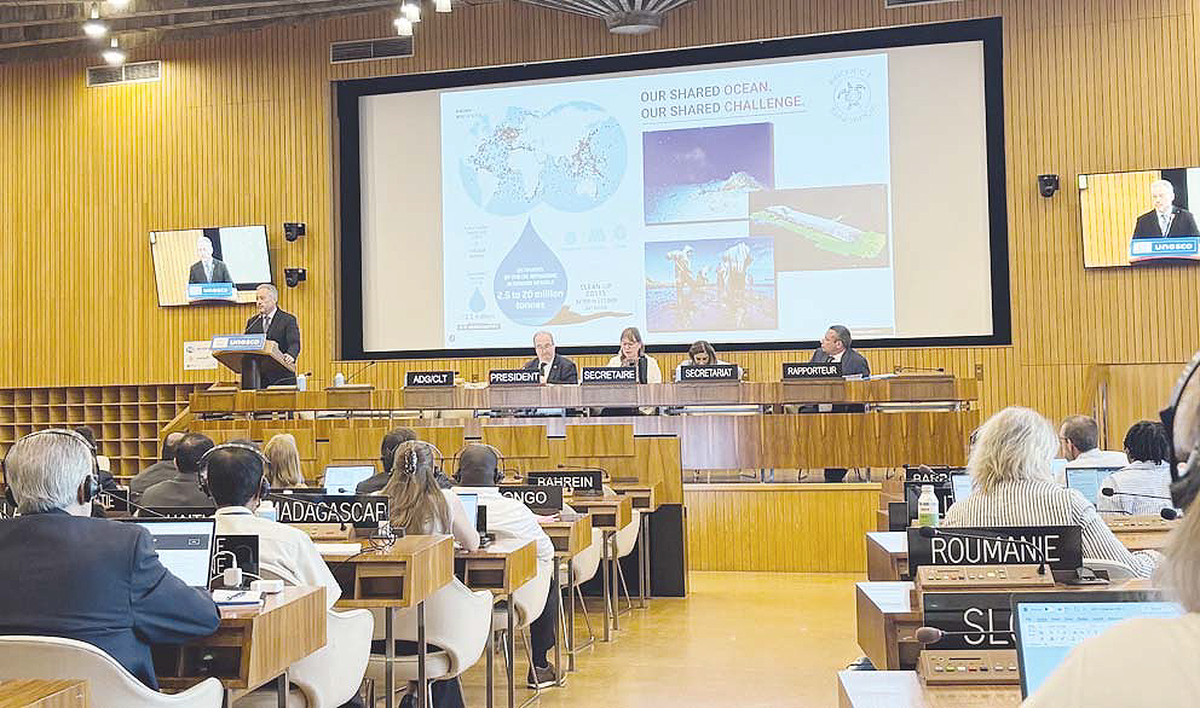26/06/2025
26/06/2025

Kuwaiti researcher joins UNESCO meetings in Paris to explore the future of underwater cultural heritage and climate resilience, as part of the Centre for International Heritage Activities delegation
Last week, from June 16-20, I had the privilege of attending a series of meetings about underwater cultural heritage and climate change at the headquarters of the United Nations Educational, Scientific and Cultural Organization (UNESCO) in Paris. This opportunity arose after a meeting in Kuwait with Dr. Robert Parthesius, founder of the Centre for International Heritage Activities (CIE) in the Netherlands, who invited me to join the CIE delegation in Paris as a researcher of maritime and underwater cultural heritage. A former professor of heritage and museum studies at New York University Abu Dhabi, Dr. Parthesius’ Amsterdam-based organization is one of approximately twenty non-governmental organizations (NGOs) accredited by UNESCO to directly facilitate the development of underwater archaeology at the national, regional, and international levels. As I am currently undertaking postgraduate research and directing a documentary film about the connections between Kuwait’s maritime and underwater cultural heritage and various sectors of Kuwait’s economy, the opportunity to join the CIE team in Paris could not be missed.

Talal Al-Muhanna, Dr. Robert Parthesius & Léa-Lydie De Bruycker representing the Centre for International Heritage Activities ("CIE") at UNESCO HQ in Paris, June 16, 2025.
2001 Convention
UNESCO’s 2001 Convention on the Protection of the Underwater Cultural Heritage is a landmark convention that aims to guide governments, NGOs, heritage professionals, and all those interested in preserving, protecting, managing, and conserving some of the most vulnerable forms and aspects of tangible cultural heritage. Abbreviated as “UCH,” underwater cultural heritage spans many millennia. It encompasses material cultural remains from the prehistoric to the modern era, including human settlements, transport vessels, and cargoes carried by those vessels. It refers to all artifacts, structures, and man-made formations situated in marine environments or inland waterways that have been in place for over 100 years, whether partially or wholly, and whether temporarily or permanently underwater. Fortunately, Kuwait is one of the many Arab countries that are a State Party to the 2001 Convention
UNESCO’s 2001 Convention on the Protection of the Underwater Cultural Heritage is a landmark convention that aims to guide governments, NGOs, heritage professionals, and all those interested in preserving, protecting, managing, and conserving some of the most vulnerable forms and aspects of tangible cultural heritage. Abbreviated as “UCH,” underwater cultural heritage spans many millennia. It encompasses material cultural remains from the prehistoric to the modern era, including human settlements, transport vessels, and cargoes carried by those vessels. It refers to all artifacts, structures, and man-made formations situated in marine environments or inland waterways that have been in place for over 100 years, whether partially or wholly, and whether temporarily or permanently underwater. Fortunately, Kuwait is one of the many Arab countries that are a State Party to the 2001 Convention
The Meeting of States Parties to the Convention
The Meeting of States Parties to the 2001 Convention takes place every two years, and the 2025 edition, which commenced on June 16, marked the tenth session. Representatives from across the Arab world were in attendance, including those from Gulf countries such as Oman and Qatar, as well as North African countries like Tunisia and Libya. Having the chance to network with like-minded archaeologists and heritage managers, exchange news, and share ideas about the situation of underwater archaeology in the Arab region was invaluable. Regarding the Gulf region, it also sparked conversation about how researchers and authorities in the Gulf Arab states might develop a network for cross-border knowledge exchange, particularly concerning the surveying, documentation, and safeguarding of underwater archaeology in the Gulf. At the same time, it was acknowledged that the more expansive Indian Ocean serves as an essential framework for discussion between archaeologists and heritage managers from the GCC and their counterparts in coastal India, Pakistan, and East Africa – places where Gulf Arabs journeyed, conducted trade, and interacted socially, culturally, and politically for centuries. Such a discussion aligns perfectly with the perspective of the Centre for International Heritage Activities, which aims to better understand the impact of heritage practices across interconnected maritime geographies and to foster knowledge exchange that leads to more inclusive cultural futures.
The Meeting of States Parties to the 2001 Convention takes place every two years, and the 2025 edition, which commenced on June 16, marked the tenth session. Representatives from across the Arab world were in attendance, including those from Gulf countries such as Oman and Qatar, as well as North African countries like Tunisia and Libya. Having the chance to network with like-minded archaeologists and heritage managers, exchange news, and share ideas about the situation of underwater archaeology in the Arab region was invaluable. Regarding the Gulf region, it also sparked conversation about how researchers and authorities in the Gulf Arab states might develop a network for cross-border knowledge exchange, particularly concerning the surveying, documentation, and safeguarding of underwater archaeology in the Gulf. At the same time, it was acknowledged that the more expansive Indian Ocean serves as an essential framework for discussion between archaeologists and heritage managers from the GCC and their counterparts in coastal India, Pakistan, and East Africa – places where Gulf Arabs journeyed, conducted trade, and interacted socially, culturally, and politically for centuries. Such a discussion aligns perfectly with the perspective of the Centre for International Heritage Activities, which aims to better understand the impact of heritage practices across interconnected maritime geographies and to foster knowledge exchange that leads to more inclusive cultural futures.

Dr. Benjamin Ferrari discusses potentially polluting wrecks (PPW) at UNESCO HQ in Paris.
The programme
The programming and events hosted by UNESCO from June 16 to 20 began with two days of official meetings of the States Parties, during which various protocols were observed, amendments to articles were drafted and debated, and progress reports were delivered. This was followed by a day-long session of the Scientific and Technical Advisory Body (or “STAB”) – which provides advice in scientific and technical matters while also contributing “to capacity building, to the development of national action plans, and to guiding States Parties in the implementation process” (UNESCO 2025). An essential indicator of the direction that future strategies appear poised to adopt was that the Secretariat intensified work on climate change and UCH, prioritizing awareness. Along these lines, major scientific conferences are planned for 2025 to foster interdisciplinary cooperation and promote heritage-based climate resilience.
The programming and events hosted by UNESCO from June 16 to 20 began with two days of official meetings of the States Parties, during which various protocols were observed, amendments to articles were drafted and debated, and progress reports were delivered. This was followed by a day-long session of the Scientific and Technical Advisory Body (or “STAB”) – which provides advice in scientific and technical matters while also contributing “to capacity building, to the development of national action plans, and to guiding States Parties in the implementation process” (UNESCO 2025). An essential indicator of the direction that future strategies appear poised to adopt was that the Secretariat intensified work on climate change and UCH, prioritizing awareness. Along these lines, major scientific conferences are planned for 2025 to foster interdisciplinary cooperation and promote heritage-based climate resilience.
Five takeaways from 5 days at UNESCO Any attempt to summarize the numerous presentations, panels, and interactive activities that took place at the UNESCO headquarters from June 16 to 20 is bound to fall short in one way or another. However, the following five subject areas were especially compelling for those interested in addressing the challenges facing UCH through mechanisms such as educational programs, cooperative networks, and policy- oriented approaches.
1. Climate crisis
The underwater archaeology community has been slow to integrate climate change science and related modeling into its research, with an overemphasis on discussing the “impacts” of climate change rather than taking proactive steps to mitigate its ongoing effects. Professor Colin Breen (University of Ulster) was particularly critical of the pace of progress within the field. Breen expressed frustration about the percentage of UCH under threat from coastal development – a situation which Gulf countries have been prone to for many years. The sense of urgency Dr. Breen conveyed was palpable, and he implored delegates to start integrating into other frameworks as a “moral duty”.
The underwater archaeology community has been slow to integrate climate change science and related modeling into its research, with an overemphasis on discussing the “impacts” of climate change rather than taking proactive steps to mitigate its ongoing effects. Professor Colin Breen (University of Ulster) was particularly critical of the pace of progress within the field. Breen expressed frustration about the percentage of UCH under threat from coastal development – a situation which Gulf countries have been prone to for many years. The sense of urgency Dr. Breen conveyed was palpable, and he implored delegates to start integrating into other frameworks as a “moral duty”.
2. Cross-sector cooperation
Echoing calls for cross-sectoral collaboration, a key takeaway from Dr. Emad Khalil’s presentation, the UNESCO Chair on Underwater Cultural Heritage, was that archaeologists should pursue cooperation with the armed forces and oil and gas companies that have jurisdiction in the marine domain being researched. Citing offshore sonar surveys conducted by Oman’s navy in Qalhat, Khalil encouraged other maritime archaeologists to adopt similar strategies to advance underwater archaeological research in their territorial waters. South Africa’s delegate advocated for integrating heritage policies into Marine Spatial Planning (MSP) and in Marine Protected Areas (MPAs), as issues of heritage were often absent from such discussions.
Echoing calls for cross-sectoral collaboration, a key takeaway from Dr. Emad Khalil’s presentation, the UNESCO Chair on Underwater Cultural Heritage, was that archaeologists should pursue cooperation with the armed forces and oil and gas companies that have jurisdiction in the marine domain being researched. Citing offshore sonar surveys conducted by Oman’s navy in Qalhat, Khalil encouraged other maritime archaeologists to adopt similar strategies to advance underwater archaeological research in their territorial waters. South Africa’s delegate advocated for integrating heritage policies into Marine Spatial Planning (MSP) and in Marine Protected Areas (MPAs), as issues of heritage were often absent from such discussions.
3. Education and training
Kalliopi Baika, an underwater archaeologist from Greece, emphasized the importance of education in her presentation, citing the two-year Master’s program in Maritime and Coastal Archaeology at Aix-Marseille University in France. Representing Alexandria University in Egypt, Dr. Emad Khalil announced that 58 students had completed its maritime archaeology programs since 2020. Divided between 36 diploma students and 22 MA students, a number of these had accomplished their studies with the support of the Honor Frost Foundation. However, the Egyptian university highlighted is the sole academic institution in the Arab world to offer such courses, indicating the overall weak representation of the underwater archaeology field at the higher education level throughout the Arab world.
Kalliopi Baika, an underwater archaeologist from Greece, emphasized the importance of education in her presentation, citing the two-year Master’s program in Maritime and Coastal Archaeology at Aix-Marseille University in France. Representing Alexandria University in Egypt, Dr. Emad Khalil announced that 58 students had completed its maritime archaeology programs since 2020. Divided between 36 diploma students and 22 MA students, a number of these had accomplished their studies with the support of the Honor Frost Foundation. However, the Egyptian university highlighted is the sole academic institution in the Arab world to offer such courses, indicating the overall weak representation of the underwater archaeology field at the higher education level throughout the Arab world.
4. Conservation
A representative from the Croatia-based International Centre for Underwater Archaeology (ICUA) in Zadar reminded delegates that efforts to bolster conservation science for underwater cultural heritage (UCH) are needed, as the discipline is currently under-served. A pilot project featuring the ‘in situ’ conservation of a rare, downed World War II aircraft was presented as an example of an ongoing underwater conservation project with a 15-year research horizon. By attaching magnesium cathodes to the submerged aircraft, the vessel’s rate of deterioration has been significantly decreased. Considering the high number of metal aircraft and shipwrecks globally, the importance of retarding deterioration of metal hulls, fuselages, and other parts cannot be understated.
A representative from the Croatia-based International Centre for Underwater Archaeology (ICUA) in Zadar reminded delegates that efforts to bolster conservation science for underwater cultural heritage (UCH) are needed, as the discipline is currently under-served. A pilot project featuring the ‘in situ’ conservation of a rare, downed World War II aircraft was presented as an example of an ongoing underwater conservation project with a 15-year research horizon. By attaching magnesium cathodes to the submerged aircraft, the vessel’s rate of deterioration has been significantly decreased. Considering the high number of metal aircraft and shipwrecks globally, the importance of retarding deterioration of metal hulls, fuselages, and other parts cannot be understated.
5. Potentially polluting wrecks
According to maritime archaeologist Dr. Benjamin Ferrari, there are at least 8,000 vessels worldwide, primarily from two World Wars, that contain a large amount of oil at risk of being released and which authorities are “not ready to deal with”. Since submerged vessels are susceptible to deterioration and collapse, sudden leakages of pollutants, such as oil, chemicals, and munitions, are a significant concern. Despite a considerable amount of finance being associated with emergency oil response, this is mainly for contemporary spills from privately owned vessels and is not specifically geared towards legacy wrecks. As such, existing resources cannot be used to solve the threat of polluting wrecks
According to maritime archaeologist Dr. Benjamin Ferrari, there are at least 8,000 vessels worldwide, primarily from two World Wars, that contain a large amount of oil at risk of being released and which authorities are “not ready to deal with”. Since submerged vessels are susceptible to deterioration and collapse, sudden leakages of pollutants, such as oil, chemicals, and munitions, are a significant concern. Despite a considerable amount of finance being associated with emergency oil response, this is mainly for contemporary spills from privately owned vessels and is not specifically geared towards legacy wrecks. As such, existing resources cannot be used to solve the threat of polluting wrecks
Moving beyond siloed research
Perhaps the main takeaway from the UNESCO-hosted meetings is that protecting our oceans, preserving underwater archaeology, and celebrating maritime cultural heritage are activities that stakeholders should pursue together, rather than in isolation, in the realms of science, academia, or culture. The broader climate crisis, which endangers underwater cultural heritage through sea level rise, more frequent storms of greater intensity, and ocean acidification, can only be addressed through cooperative action on an interdisciplinary basis. Likewise, the grave threat to the marine environment from Potentially Polluting Wrecks (PPW) cannot be prevented or, at the very least, mitigated without cross-sector collaboration among scientists, policymakers, industry, and maritime communities
Perhaps the main takeaway from the UNESCO-hosted meetings is that protecting our oceans, preserving underwater archaeology, and celebrating maritime cultural heritage are activities that stakeholders should pursue together, rather than in isolation, in the realms of science, academia, or culture. The broader climate crisis, which endangers underwater cultural heritage through sea level rise, more frequent storms of greater intensity, and ocean acidification, can only be addressed through cooperative action on an interdisciplinary basis. Likewise, the grave threat to the marine environment from Potentially Polluting Wrecks (PPW) cannot be prevented or, at the very least, mitigated without cross-sector collaboration among scientists, policymakers, industry, and maritime communities
By Talal Al-Muhanna


